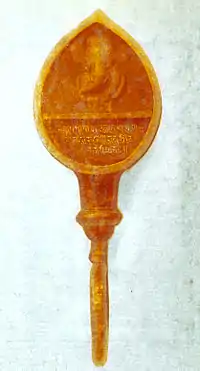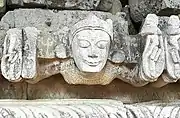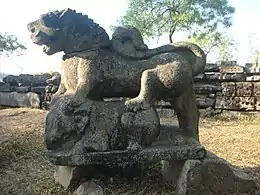Kamarupa – Late to end period
Kamarupa – Late to end period was a period of Kamarupa kingdom from founding of Pala Dynasty by Brahma Pala to last ruler of dynasty Jaya Pala.
| Part of a series on the |
| History of Kamarupa |
|---|
 |
| Ruling dynasties |
| Part of a series on the |
| History of Assam |
|---|
 |
| Categories |
|
Foundation of Pala Dynasty
Brahma Pala became the ruler of Kamarupa when Tyaga Singha of Mlechha dynasty died heirless to succeed him the people elected Brahma Pala to be their king. The ruler was legitimized with the claim that Brahma Pala was a descendant of the Varman dynasty and that he was elected by the people. He married Kula Devi by whom he had it son named Ratna Pala. It is not known whether Brahma Pala had a long reign like his son but it appears that when Ratna Pala grew up Brahma Pala abdicated in his favour.[1]
Outside invasions
During Brahma Pala's reign Kamarupa was attacked by Jatavarman, son of Vajravarman of the Varman dynasty which ruled probably in Eastern Magadha when the Pala power began to wane. This invasion is mentioned in the Belava copper-plate inscription of Bhojavarman,[1] the grandson of Jatavarman, who thereby granted lands in the Paundra bhukti, the grant being issued from the victorious camp at Vikramapura. It is stated in verse 8 of this inscription that It appears that Jatavarman invaded Kamarupa and defeated its king but could not annex the kingdom. It is probable that after this defeat Brahma Pala abdicated in favour of his son Ratna Pala who appears to have removed the capital to Guwahati, on the banks of the Brahmaputra, and, after fortifying it, called it Durjaya or impregnable.
Capital
Ratna Pala fortified the capital city called it Sri-Durjaya.
There are two copper-plate inscriptions of Ratna Pala, known as the Bargaon and the Sualkuchi grants.[2]
Line of Kings

See also
References
- Epigraphia Indica - vol XII, p.37
- Epigraphia Indica - Volume 30 (1987), p.204
Further reading
- Vasu, Nagendranath (1922). The Social History of Kamarupa.
- Tripathi, Chandra Dhar (2008). Kamarupa-Kalinga-Mithila politico-cultural alignment in Eastern India : history, art, traditions. Indian Institute of Advanced Study. p. 197.
- Majumdar, Ramesh Chandra (1977). Ancient India. Motilal Banarsidass Publications. p. 538.
- Kapoor, Subodh (2002). Encyclopaedia of ancient Indian geography. Cosmo Publications. p. 364.
- Sen, Sailendra Nath (1999). Ancient Indian History and Civilization. New Age International. p. 668.
- Kapoor, Subodh (2002). The Indian encyclopaedia: biographical, historical, religious,administrative, ethnological, commercial and scientific. Genesis Publishing Pvt Ltd. p. 320.
- Sarkar, Ichhimuddin (1992). Aspects of historical geography of Pragjyotisha-Kamarupa (ancient Assam). Naya Prokash. p. 295.
- Deka, Phani (2007). The great Indian corridor in the east. Mittal Publications. p. 404.
- Pathak, Guptajit (2008). Assam's history and its graphics. Mittal Publications. p. 211.
- Samiti, Kamarupa Anusandhana (1984). Readings in the history & culture of Assam. Kamrupa Anusandhana Samiti. p. 227.